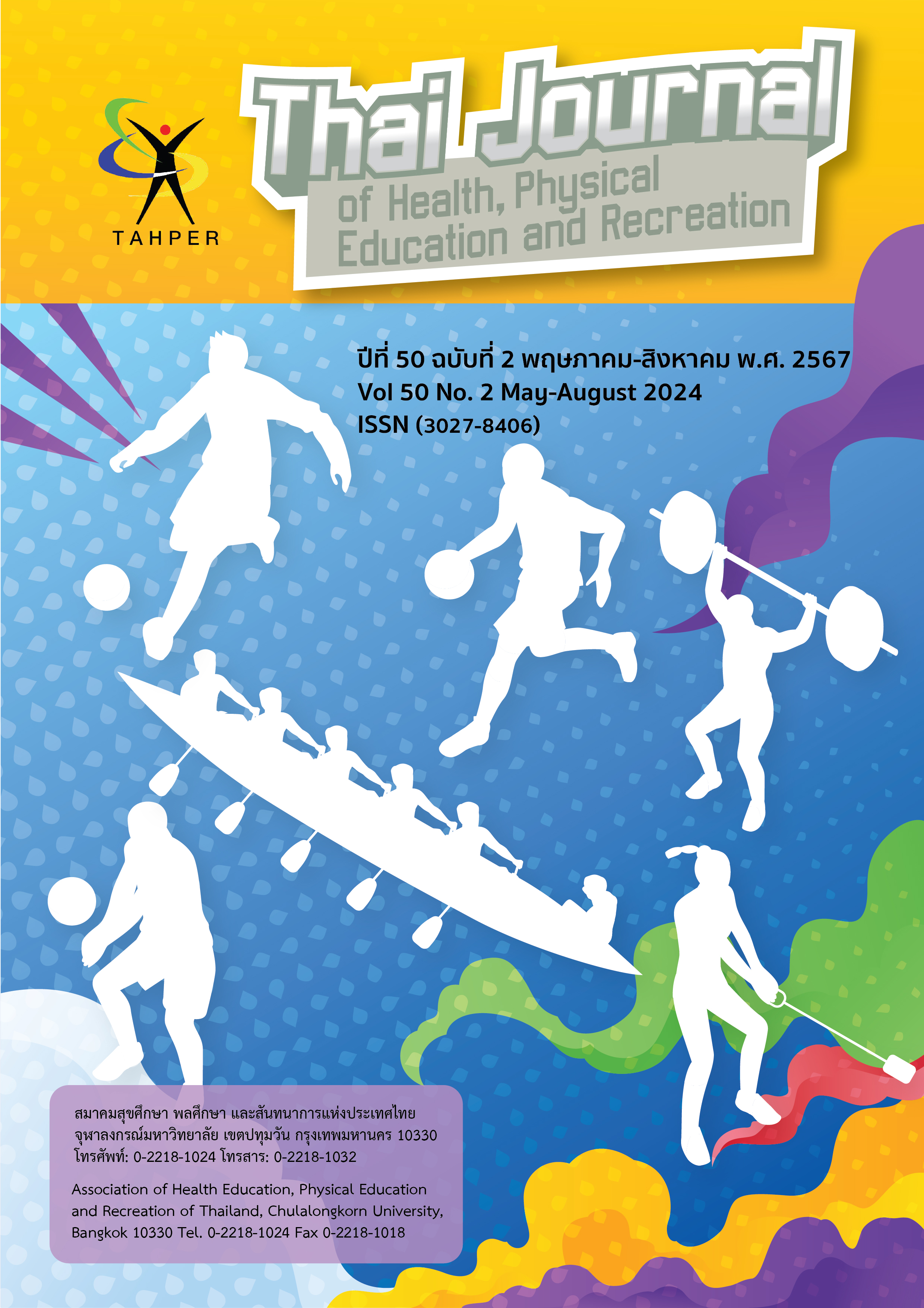A Construction of 4 Meters Gait Speed Norms for the Elderly
Main Article Content
Abstract
The purpose of this research was to construct the 4 meters gait speed norms for the elderly. The Samples were 400 elderly (Males =111; Females = 289) who aged over 60 year old and lived in southern of Thailand. The sample was obtained by using a multistage sampling method. The instrument used for this research were 4 meters gait speed test that was determined by 7 experts for face validity and test-retest method was conducted to determine the reliability. The data was analyzed by mean, standard deviation and person product moment correlation. The results show the face validity of 4 meters gait speed was in a very good level (1.00) and the reliability of the 4 meters gait speed was in a very good level (0.95). The norms of 4 meters gait speed for elderly were divided into three levels: good, moderate and low. The norms of the 4 meters gait speed for males aged from 60-69 years old were as follows: the good level was ≥ 0.53, the moderate level was between 0.36- 0.52, and the low level was ≤ 0.35. The norms of the 4 meters gait speed for males aged from 70-79 years old were as follows: the good level was ≥ 0.65, the moderate level was between 0.37- 0.64, and the low level was ≤ 0.36. The norms of the 4 meters gait speed for males aged over 80 years old were as follows: the good level was ≥ 0.75, the moderate level was between 0.43- 0.74, and the low level was ≤ 0.42.The norms of the 4 meters gait speed for females aged from 60-69 years old were as follows: the good level was ≥ 0.56, the moderate level was between 0.36- 0.55, and the low level was ≤ 0.35. The norms of the 4 meters gait speed for females aged from 70-79 years old were as follows: the good level was ≥ 0.68, the moderate level was between 0.37- 0.67, and the low level was ≤ 0.36. The norms of the 4 meters gait speed for females aged over 80 years old were as follows: the good level was ≥ 0.76, the moderate level was between 0.43- 0.75, and the low level was ≤ 0.43. In conclusion, the 4 meters gait speed was a test that a very good level of validity and reliability. It is easy to use and uncomplicated that is suitable for testing with the elderly. The norms of 4 meters gait speed can be use to assess the walking speed of the elderly.
Article Details

This work is licensed under a Creative Commons Attribution-NonCommercial-NoDerivatives 4.0 International License.
Critical thinking in journals is the right of the author. The Association of Health Education, Physical Education and Recreation of Thailand is not always required, to create diversity in ideas and creativity.
ความคิด ข้อวิพากษ์ในวารสารเป้นสิทธิของผู้เขียน สมาคมสุขศึกษา พลศึกษา และสันทนาการแห่งประเทศไทยไม่จำเป็นต้องเห็นชอบด้วยเสมอไป เพื่อให้เกิดความหลากหลายในความคิดและความสร้างสรรค์
References
กฤษณา พิรเวช. (2552). การฟื้นฟูผู้ป่วยโรคหลอดเลือดสมอง. ใน ดุจใจ ชัยวานิชศิริและวสุวัฒน์กิติสมประยูรกุล (บรรณาธิการ), ตําราเวชศาสตร์ฟื้นฟู. กรุงเทพฯ:โรงพิมพ์แห่งจุฬาลงกรณ์มหาวิทยาลัย.
เจริญ กระบวนรัตน์. (2556). การออกกำลังกายเพื่อสุขภาพและพัฒนาบุคลิกภาพ. เอกสารประกอบโครงการเชิงปฏิบัติการ มหาลัยรามคำแหง กรุงเทพมหานคร. (อัดสำเนา).
มูลนิธิสถาบันวิจัยและพัฒนาผู้สูงอายุไทย. (2559).สถานการณ์ผู้สูงอายุไทย 2558. (พิมพ์ครั้งที่1). กรุงเทพฯ : บริษัท อมรินทร์พริ้นติ้งแอนด์พับลิชชิ่ง.
บุญชม ศรีสะอาด. (2535). การวิจัยเบื้องต้น. (พิมพ์ครั้งที่ 2). กรุงเทพฯ: สุวิริยาสานส์น.
พวงรัตน์ มณีรัตน์. (2535). วิธีการวิจัยทางพฤติกรรมศาสตร์และสังคมศาสตร์. (พิมพ์ครั้งที่ 4). กรุงเทพฯ:สำนักทดสอบทางการศึกษาและจิตวิทยา มหาวิทยาลัยศรีนครินทรวิโรฒ ประสานมิตร.
วิริยา บุญชัย. (2529). การทดสอบและการวัดผลพลทางพลศึกษา. (พิมพ์ครั้งที่ 2). กรุงเทพฯ: ไทยวัฒนาพานิช. สถาบันเวชศาสตร์ผู้สูงอายุ . (2549). แนวทางเวชปฎิบัติการจัดกิจกรรมทางกายสำหรับผู้สูงอายุกับโรคหัวใจ. กรุงเทพมหานคร : ชุมชนสหกรณ์การเกษตรแห่งประเทศไทยจำกัด
Bohannon RW. 1989. Selected determinants of ambulatory capacity in patients with hemiplegia. ClinRehabil, 3:47-53.
Cesari, M., Kritchevsky, S. B., Penninx, B. W., Nicklas, B. J., Simonsick, E. M., Newman, A. B., & Visser, M. (2005). Prognostic value of usual gait speed in well-functioning older people-resultsfrom the Health, Aging and BodyComposition Study. Journal of the American Geriatrics Society, 53(10), 1675-1680.
Collen, F. M., Wade, D. T., & Bradshaw, C. M. 1990. Mobility after stroke: reliability of measures of impairment and disability. Int Disabil Stud, 12(1), 6-9.
Hardy, S. E., Perera, S., Roumani, Y. F., Chandler, J. M., &Studenski, S. A. 2007. Improvement in usual gait speed predicts better survival in older adults. J Am Geriatr Soc, 55(11).
Hardy, S. E., Perera, S., Roumani, Y. F., Chandler, J. M., & Studenski, S. A. (2007). Improvement in usual gait speed predicts better survival in older adults. Journal of the American Geriatrics Society, 55(11), 1727-1734.
Kollen B, Kwakkel G, Lindeman E. (2006). Hemiplegic gait after stroke: is measurement of maximum speed required?. Archives of Physical Medicine and Rehabilitation, 87:358-63.
Rikli, R., and Jones, J. (2001). Senior Fitness Test Manual. Champaign: Human kinetics.
Van Hedel, H. J., Dietz, V., & Curt, A. (2007). Assessment of walking speed and distance in subjects with an incomplete spinal cord injury. Neurorehabil Neural Repair, 21(4), 295-301.
Wilson, R. S., Schneider, J. A., Beckett, L. A., Evans, D. A., & Bennett, D. A. (2002). Progression of gait disorder and rigidity and risk of death in older persons. Neurology, 58 (12), 1815-1819.


